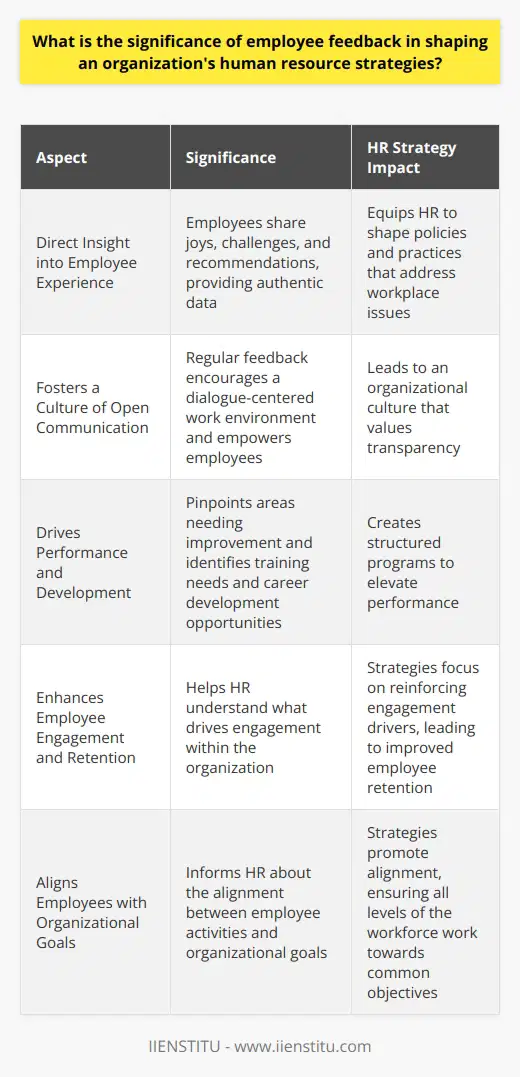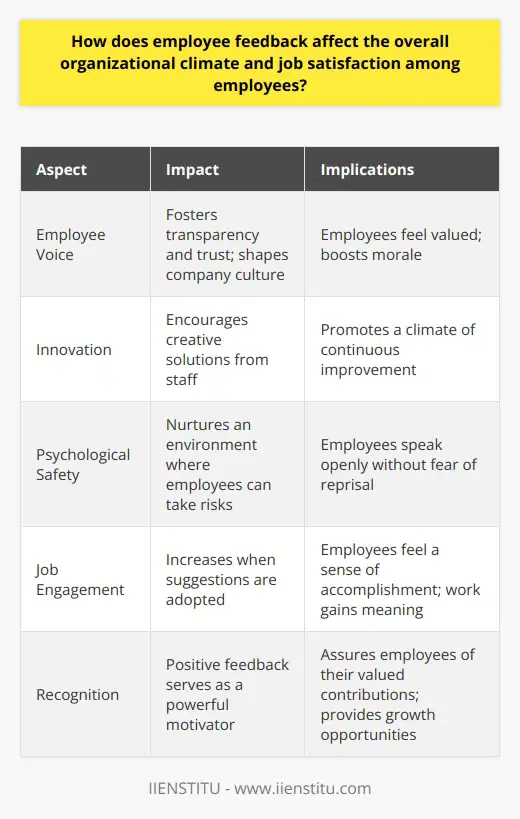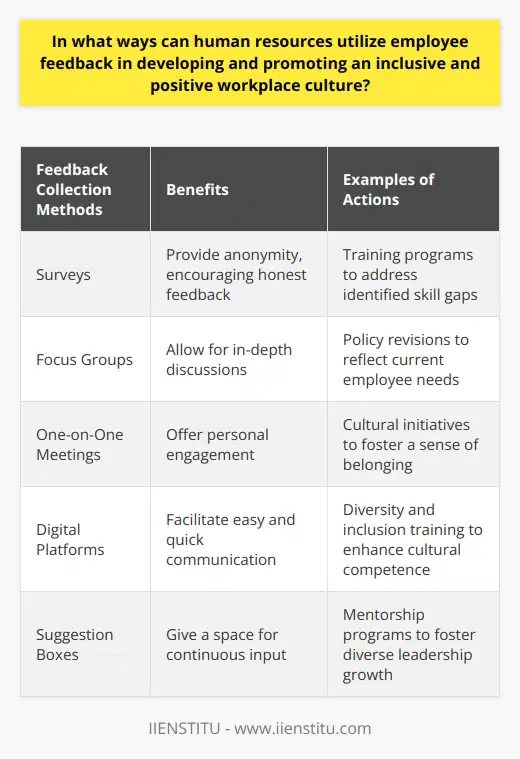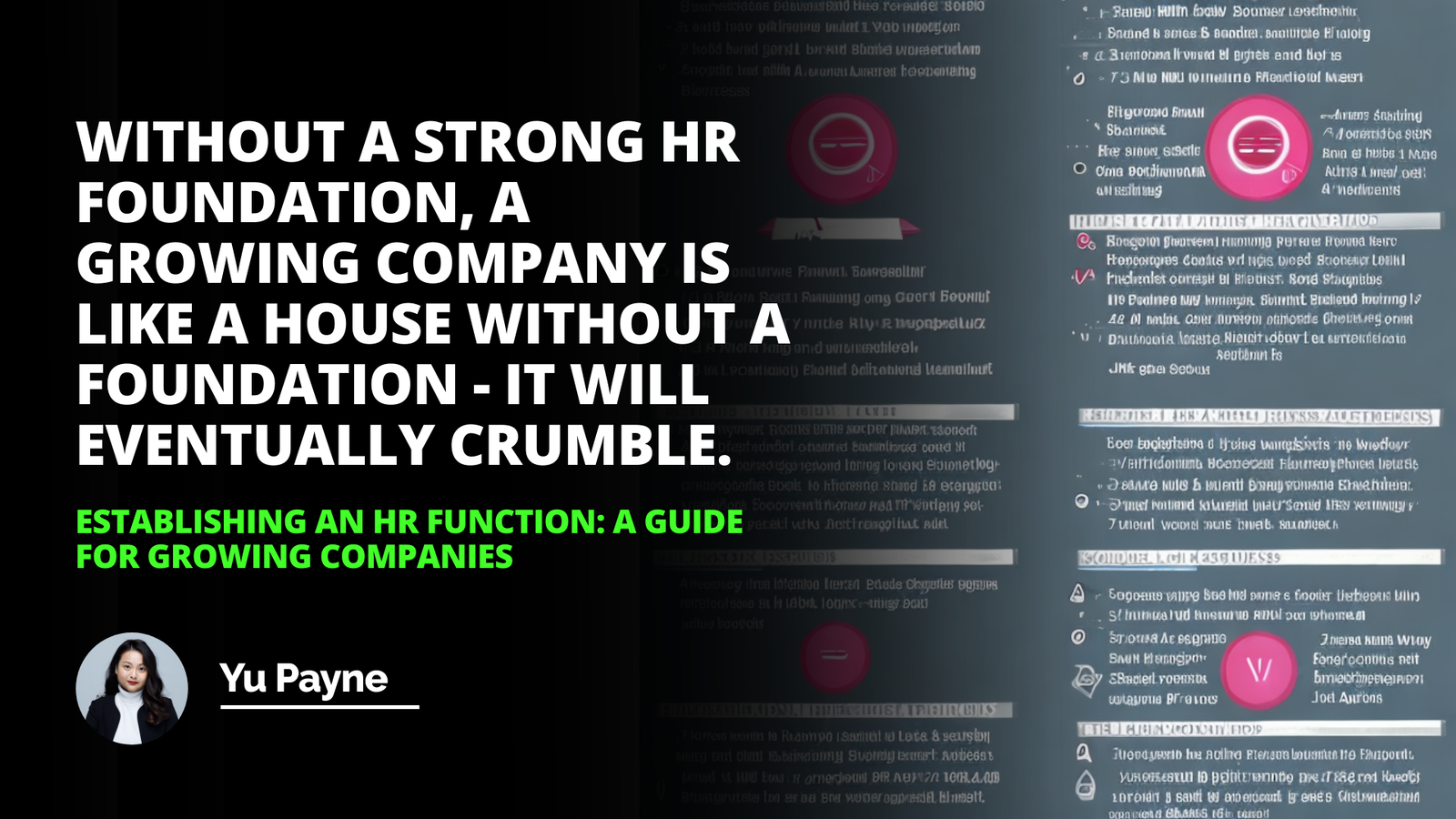
In today's fast-paced and ever-evolving business landscape, organizations are constantly seeking ways to stay ahead of the curve and maintain a competitive edge. While there are many factors that contribute to a company's success, one often overlooked aspect is the role of employee feedback in driving growth and unlocking potential.
As someone who has worked in various HR roles over the past decade, I have seen firsthand the transformative power of employee feedback. When done right, it can foster a culture of open communication, boost employee engagement, and ultimately lead to better business outcomes. In this blog post, I will share my insights and experiences on why employee feedback matters, how to gather it effectively, and what to do with the insights gained.
Why Employee Feedback Matters

Before diving into the tactics of gathering and utilizing employee feedback, let's first understand why it's so crucial. Here are three key reasons:
1. It Helps Identify Areas for Improvement
No organization is perfect, and there will always be areas that need improvement. However, it can be challenging for leaders to pinpoint these areas on their own, especially if they are not in tune with the day-to-day experiences of their employees. This is where employee feedback comes in.
By actively seeking input from employees at all levels, organizations can gain valuable insights into what's working well and what needs to be fixed. This could be anything from inefficient processes and communication breakdowns to issues with management styles and company culture.
I remember an instance from my previous job where we conducted an anonymous employee survey and discovered that many team members felt they lacked clear direction and support from their managers. This feedback was eye-opening for our leadership team and led to the implementation of a more structured performance management system and regular check-ins between managers and their direct reports. The result? Increased clarity, improved morale, and ultimately better performance across the board.
2. It Boosts Employee Engagement and Retention
Engaged employees are the lifeblood of any successful organization. They are more productive, more committed, and more likely to stick around for the long haul. However, engagement doesn't happen by accident – it requires intentional effort from leaders to create an environment where employees feel valued, heard, and supported.
One of the most effective ways to boost engagement is through regular employee feedback. When employees feel that their opinions matter and that their contributions are recognized, they are more likely to go above and beyond in their roles. Moreover, by involving employees in decision-making processes and giving them a voice in shaping the direction of the company, organizations can foster a sense of ownership and loyalty that is hard to replicate.
3. It Drives Innovation and Growth
In today's fast-paced business environment, innovation is no longer a nice-to-have – it's a necessity for survival. Companies that fail to adapt and evolve risk being left behind by their more agile competitors. However, innovation doesn't happen in a vacuum – it requires a culture that encourages creativity, risk-taking, and continuous learning.
Employee feedback can be a powerful tool for driving innovation within an organization. By tapping into the diverse perspectives and experiences of employees, leaders can uncover new ideas and approaches that they may not have considered otherwise. Moreover, by creating a safe space for employees to share their thoughts and opinions, organizations can foster a culture of experimentation and continuous improvement.
How to Gather Employee Feedback Effectively

Now that we understand the importance of employee feedback, let's explore some effective strategies for gathering it:
1. Conduct Regular Surveys
One of the most common ways to gather employee feedback is through surveys. These can be conducted annually, quarterly, or even more frequently depending on the needs of the organization. Surveys can cover a wide range of topics, from job satisfaction and engagement to perceptions of company culture and leadership.
When designing a survey, it's important to keep a few key principles in mind:
Keep it short and focused: Employees are busy, so aim for a survey that takes no more than 10-15 minutes to complete.
Use a mix of open-ended and closed-ended questions: Closed-ended questions (e.g. rating scales) can provide quantitative data, while open-ended questions allow for more qualitative insights.
Ensure anonymity: Employees are more likely to be honest if they know their responses will be kept confidential.
Follow up on the results: Don't let the survey results sit on a shelf – use them to inform action plans and communicate progress back to employees.
2. Hold Regular Check-Ins
While surveys can provide valuable insights at a macro level, they don't replace the need for regular one-on-one conversations between managers and their direct reports. These check-ins provide an opportunity for employees to share their successes, challenges, and ideas in a more informal setting.
As a manager, I make it a point to schedule bi-weekly check-ins with each member of my team. During these conversations, I ask open-ended questions like:
What's going well in your role right now?
What challenges are you facing, and how can I support you?
What ideas do you have for improving our team or the company as a whole?
By creating a safe and supportive space for these conversations, I've been able to build stronger relationships with my team members and gain valuable insights into how I can be a better leader.
3. Encourage Continuous Feedback
While surveys and check-ins are important, they shouldn't be the only opportunities for employees to share their thoughts and opinions. Instead, organizations should strive to create a culture of continuous feedback where employees feel empowered to speak up and share their ideas on an ongoing basis.
One way to encourage continuous feedback is through the use of anonymous suggestion boxes (either physical or digital). This allows employees to share their thoughts without fear of retribution or judgment.
Another approach is to create cross-functional teams or committees focused on specific areas of the business (e.g. employee engagement, diversity and inclusion, etc.). These teams can serve as a forum for employees to share their perspectives and collaborate on solutions.
Turning Feedback into Action
Gathering employee feedback is only half the battle – the real challenge lies in turning those insights into meaningful action. Here are a few tips for making the most of employee feedback:
1. Prioritize and Plan
Not all feedback will be actionable or relevant, so it's important to prioritize the insights that are most critical to the success of the organization. Once you've identified the key themes and areas for improvement, create a clear action plan with specific goals, timelines, and owners.
2. Communicate Progress
Employees want to know that their feedback is being heard and acted upon, so it's important to communicate progress regularly. This could be through company-wide updates, team meetings, or individual conversations.
3. Celebrate Successes
When you do make progress on key initiatives or address specific pieces of feedback, take the time to celebrate those successes. This could be through public recognition, team bonding events, or other rewards. By celebrating wins, you reinforce the importance of employee feedback and create a positive feedback loop.
Conclusion
Employee feedback is a powerful tool for driving growth, engagement, and innovation within organizations. By actively seeking input from employees at all levels, leaders can gain valuable insights into areas for improvement and opportunities for growth.
However, gathering feedback is only the first step – the real impact comes from turning those insights into meaningful action. By prioritizing key themes, communicating progress, and celebrating successes, organizations can create a culture of continuous improvement and unlock the full potential of their people.
As an HR professional, I've seen the transformative power of employee feedback firsthand. By making it a core part of your people strategy, you can create a more engaged, innovative, and successful organization. So start the conversation today – your employees (and your bottom line) will thank you.
Frequently Asked Questions
What is the significance of employee feedback in shaping an organization's human resource strategies?
Significance of Employee Feedback in Human Resource Strategies
Employee feedback forms a keystone in organizational development. It offers a basis for enhancing strategies within human resources (HR). HR professionals rely on feedback to gauge employee satisfaction and engagement.
Direct Insight into Employee Experience
Through feedback, employees communicate their workplace experiences. They share joys, challenges, and recommendations. This insight places HR in an ideal position to address workplace issues. It equips HR with authentic data to shape policies and practices.
Fosters a Culture of Open Communication
Regular feedback encourages a dialogue-centered work environment. It empowers employees, showing that their opinions matter. This openness can lead to an organizational culture that values transparency.
Drives Performance and Development
Feedback pinpoints areas needing improvement. It identifies training needs and career development opportunities. HR strategies then hone in on these areas. They create structured programs to elevate performance.
Enhances Employee Engagement and Retention
Engaged employees invest more in their work. Feedback helps HR understand what drives engagement within the organization. Strategies can then focus on reinforcing these drivers. This leads to improved employee retention.
Aligns Employees with Organizational Goals
An organization thrives when its workforce aligns with its goals. Feedback informs HR about the alignment between employee activities and these goals. Strategies can promote this alignment. They ensure that all levels of the workforce work towards common objectives.
Informs Compensation and Benefits
Fairness in compensation maintains morale. Employee feedback reveals how staff perceive their benefits and pay. HR strategies use this information. They ensure that reward systems are both competitive and equitable.
Tailors Recognition and Reward Systems
Recognition fuels motivation. Feedback outlines what employees value in terms of recognition. HR strategies can thus tailor reward systems. They match employee preferences with organizational capabilities.
Facilitates Change Management
Organizations undergo constant change. Feedback is critical during these transitions. It provides HR with employee perspectives on change. Strategies can thus ease resistance. They smooth the transition process.
Mitigates Risks
Feedback can signal potential risks. Examples include burnout or compliance issues. HR undertakes preemptive strategies. They mitigate risks before they escalate.
Supports Diversity and Inclusion
Workforce diversity enriches an organization. Feedback informs HR about inclusivity concerns. Strategies foster a culture where diversity thrives.
Helps in Succession Planning
Feedback identifies potential leaders among the staff. This aids HR in succession planning. Organizations thus prepare for future leadership needs.
To conclude, employee feedback is indispensable in crafting HR strategies. It serves as a compass for organizational improvement. Feedback grounds HR efforts in reality. It ensures that strategies resonate with employee needs while advancing organizational objectives.

How does employee feedback affect the overall organizational climate and job satisfaction among employees?
Understanding Employee Feedback
Employee feedback stands as a critical aspect of organizational success. It comprises insights, concerns, and suggestions from staff. This feedback informs management decisions. It can improve processes and the work environment. On one hand, it fosters transparency. On the other, it helps to establish trust.
Impact on Organizational Climate
The organizational climate reflects employees' perception. It covers norms, values, and attitudes present within the company. Feedback directly influences this climate. It provides a channel for employee voice. This voice shapes the company's cultural fabric. Employees feel valued when leaders listen. Their morale thus boosts.
Feedback also sparks innovation. It encourages creative solutions from staff. The climate becomes one of continuous improvement. Everyone participates. Everyone owns the change process. An open feedback culture nurtures psychological safety. Employees dare to take risks. They speak openly without fear of reprisal.
Influence on Job Satisfaction
Job satisfaction relates to how employees feel about their roles. Feedback plays a significant role in this regard. When staff see their suggestions adopted, their job engagement soars. They feel a sense of accomplishment. Their work gains meaning. Their motivation rises.
Recognition is another factor influenced by feedback. Positive feedback serves as a powerful motivator. It assures employees of their valued contributions. Conversely, constructive feedback provides growth opportunities. Employees appreciate chances to improve and develop their skills.
The Domino Effect of Feedback
Feedback creates a domino effect. It starts with individual employees. It extends to the organizational climate and job satisfaction. Happy employees translate to satisfied customers. Satisfied customers yield better business outcomes. The company’s success hinges on the loop of feedback and responsive action.
Leaders must prioritize feedback mechanisms. They must ensure these systems are effective and user-friendly. Soliciting feedback alone does not suffice. Management must act on it. They should communicate changes back to staff. This cycle reinforces a culture of trust and respect.
In summary, employee feedback crucially shapes the organizational climate. It boosts job satisfaction. Organizations must regard feedback as a strategic resource. They must harvest and utilize it wisely. This optimization will foster a thriving workplace for all.

In what ways can human resources utilize employee feedback in developing and promoting an inclusive and positive workplace culture?
Understanding Employee Feedback
Human resources (HR) professionals recognize that employee feedback is vital. They use it to shape a positive and inclusive workplace culture. This feedback often reveals insights into the workforce's morale, engagement, and satisfaction. It can have its basis in formal surveys, performance reviews, or informal channels. By actively listening, HR can diagnose issues and identify opportunities for improvement.
Gathering Feedback
HR must use various tools to collect feedback. Surveys, focus groups, and suggestion boxes are common. So are one-on-one meetings and digital platforms. The goal is a comprehensive understanding of employee sentiments.
- Surveys provide anonymity, encouraging honest feedback.
- Focus groups allow for in-depth discussions.
- Suggestion boxes give a space for continuous input.
- Meetings offer personal engagement.
- Digital platforms facilitate easy and quick communication.
Analyzing Feedback
After collection, HR must analyze feedback carefully. They must look for patterns, common themes, and outliers. Tools like sentiment analysis software can help. This step is crucial to accurately interpreting the workforce's voice.
- Patterns indicate widespread concerns or successes.
- Themes reveal areas for cultural development.
- Outliers may show individual or unique issues.
Acting on Feedback
HR must act on feedback for employees to see their input matters. Action can take many forms. Training programs, policy revisions, and cultural initiatives are examples. By doing so, HR shows a commitment to employee concerns.
- Training can address identified skill gaps.
- Policy revisions can reflect current employee needs.
- Cultural initiatives foster a sense of belonging.
Communicating Actions
Communication is key in demonstrating HR's responsiveness. Employees should know that their feedback has led to changes. Regular updates foster transparency and trust.
- Updates can be via email, meetings, or company intranets.
- Transparency strengthens trust in HR processes.
- Trust encourages ongoing employee engagement in feedback.
Promoting Inclusivity
Feedback can highlight inclusivity issues in the workplace. HR can then develop targeted diversity and inclusion initiatives. Training can enhance cultural competence. Mentorship programs can foster diverse leadership growth.
- Diversity training educates and sensitizes staff.
- Inclusion initiatives create a supportive environment.
- Mentorship promotes diverse representation in leadership.
Fostering a Positive Culture
Employee feedback helps create a positive work culture. Recognition programs can arise from feedback indicating such a need. Wellness programs can address work-life balance concerns. Social events can enhance team cohesion.
- Recognition rewards and motivates employees.
- Wellness programs show care for employee well-being.
- Social events build camaraderie and team spirit.
Continuous Improvement
Finally, HR must view feedback as part of a continuous improvement process. It's not a one-time exercise. Regular feedback loops ensure ongoing cultural growth and adaptability.
- Regular feedback loops catch evolving issues early.
- Cultural growth becomes part of the organization's DNA.
- Adaptability ensures the culture remains relevant and supportive.
In conclusion, HR can lead the charge in creating a positive, inclusive workplace. Employee feedback is the compass that guides this journey. Each step, from collection to action, is crucial. Clear communication, targeted initiatives, and continuous improvement close the loop. It transforms feedback into cultural change. The outcome is a workplace where every voice matters, and every employee thrives.



